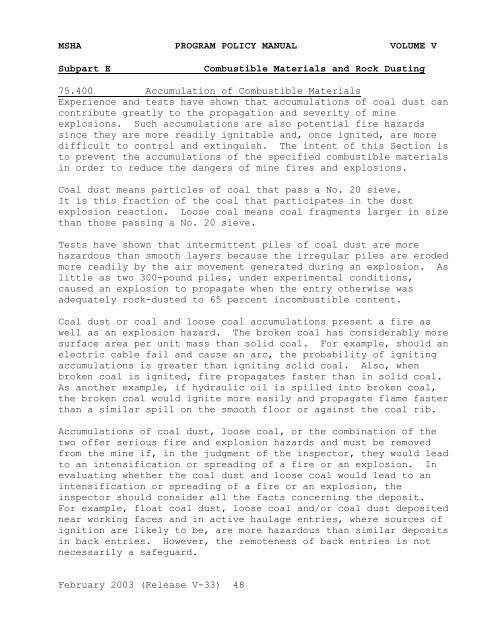Program Policy Manual - VOLUME V - Mine Safety and Health ...
Program Policy Manual - VOLUME V - Mine Safety and Health ...
Program Policy Manual - VOLUME V - Mine Safety and Health ...
You also want an ePaper? Increase the reach of your titles
YUMPU automatically turns print PDFs into web optimized ePapers that Google loves.
MSHA PROGRAM POLICY MANUAL <strong>VOLUME</strong> V<br />
Subpart E Combustible Materials <strong>and</strong> Rock Dusting<br />
75.400 Accumulation of Combustible Materials<br />
Experience <strong>and</strong> tests have shown that accumulations of coal dust can<br />
contribute greatly to the propagation <strong>and</strong> severity of mine<br />
explosions. Such accumulations are also potential fire hazards<br />
since they are more readily ignitable <strong>and</strong>, once ignited, are more<br />
difficult to control <strong>and</strong> extinguish. The intent of this Section is<br />
to prevent the accumulations of the specified combustible materials<br />
in order to reduce the dangers of mine fires <strong>and</strong> explosions.<br />
Coal dust means particles of coal that pass a No. 20 sieve.<br />
It is this fraction of the coal that participates in the dust<br />
explosion reaction. Loose coal means coal fragments larger in size<br />
than those passing a No. 20 sieve.<br />
Tests have shown that intermittent piles of coal dust are more<br />
hazardous than smooth layers because the irregular piles are eroded<br />
more readily by the air movement generated during an explosion. As<br />
little as two 300-pound piles, under experimental conditions,<br />
caused an explosion to propagate when the entry otherwise was<br />
adequately rock-dusted to 65 percent incombustible content.<br />
Coal dust or coal <strong>and</strong> loose coal accumulations present a fire as<br />
well as an explosion hazard. The broken coal has considerably more<br />
surface area per unit mass than solid coal. For example, should an<br />
electric cable fail <strong>and</strong> cause an arc, the probability of igniting<br />
accumulations is greater than igniting solid coal. Also, when<br />
broken coal is ignited, fire propagates faster than in solid coal.<br />
As another example, if hydraulic oil is spilled into broken coal,<br />
the broken coal would ignite more easily <strong>and</strong> propagate flame faster<br />
than a similar spill on the smooth floor or against the coal rib.<br />
Accumulations of coal dust, loose coal, or the combination of the<br />
two offer serious fire <strong>and</strong> explosion hazards <strong>and</strong> must be removed<br />
from the mine if, in the judgment of the inspector, they would lead<br />
to an intensification or spreading of a fire or an explosion. In<br />
evaluating whether the coal dust <strong>and</strong> loose coal would lead to an<br />
intensification or spreading of a fire or an explosion, the<br />
inspector should consider all the facts concerning the deposit.<br />
For example, float coal dust, loose coal <strong>and</strong>/or coal dust deposited<br />
near working faces <strong>and</strong> in active haulage entries, where sources of<br />
ignition are likely to be, are more hazardous than similar deposits<br />
in back entries. However, the remoteness of back entries is not<br />
necessarily a safeguard.<br />
February 2003 (Release V-33) 48
















